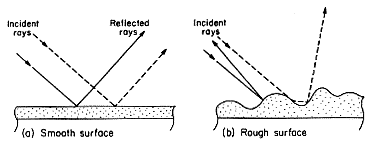The Reflection of Light
All Things Reflected
What is it about objects that let us see them? Why do we see the road, or a pen, or a best friend? If an object does not emit its own light (which accounts for most objects in the world), it must reflect light in order to be seen. The walls in the room that you are in do not emit their own light; they reflect the light from the ceiling "lights" overhead. Polished metal surfaces reflect light much like the silver layer on the back side of glass mirrors. A beam of light incident on the metal surface is reflected.
Reflection involves two rays - an incoming or incident ray and an outgoing or reflected ray. In Figure 1 we use a single line to illustrate a light ray reflected from the surface. The law of reflection requires that two rays are at identical angles but on opposite sides of the normal which is an imaginary line (dashed in Fig. 1) at right angles to the mirror located at the point where the rays meet. We show in Fig. 1 that the angles of incidence i and reflection i' are equal by joining the two angles with an equal sign.

Figure. 1 Light reflected from a metal surface with angle of incidence i equal to the angle of reflection i'. The dashed line (normal) is perpendicular to the surface.
All Things Equal
All reflected light obeys the relationship, called Snell's Law, that the angle of incidence equals the angle of reflection. Just as images are reflected from the surface of a mirror, light reflected from a smooth water surface also produced a clear image. We call the reflection from a smooth, mirror-like surface specular (as shown in Figure 2a). When the surface of water is wind-blown and irregular, the rays of light are reflected in many directions. The law of reflection is still obeyed, but the incident rays (Fig. 2b) strike different regions which are inclined at different angles to each other. Consequently, the outgoing rays are reflected at many different angles and the image is disrupted. Reflection from such a rough surface is called diffuse reflection and appears matte.

Figure. 2 Light reflection from a) smooth surface (specular reflection ) and b) rough surface (diffuse reflection). In both cases the angle of incidence equals the angle of reflection at the point that the light ray strikes the surface.
Light is also reflected when it is incident on a surface or interface between two different materials such as the surface between air and water, or glass and water. Each time a ray of light strikes a boundary between two materials - air/glass or glass/water - some of the light is reflected. The laws of reflection are obeyed at all interfaces. The amount of reflected light at the interface depends on the differences in refraction between the two adjoining materials.
Want to try activities highlighting these principles? Click on the name of this activity to find an easy, hands-on experiment:









